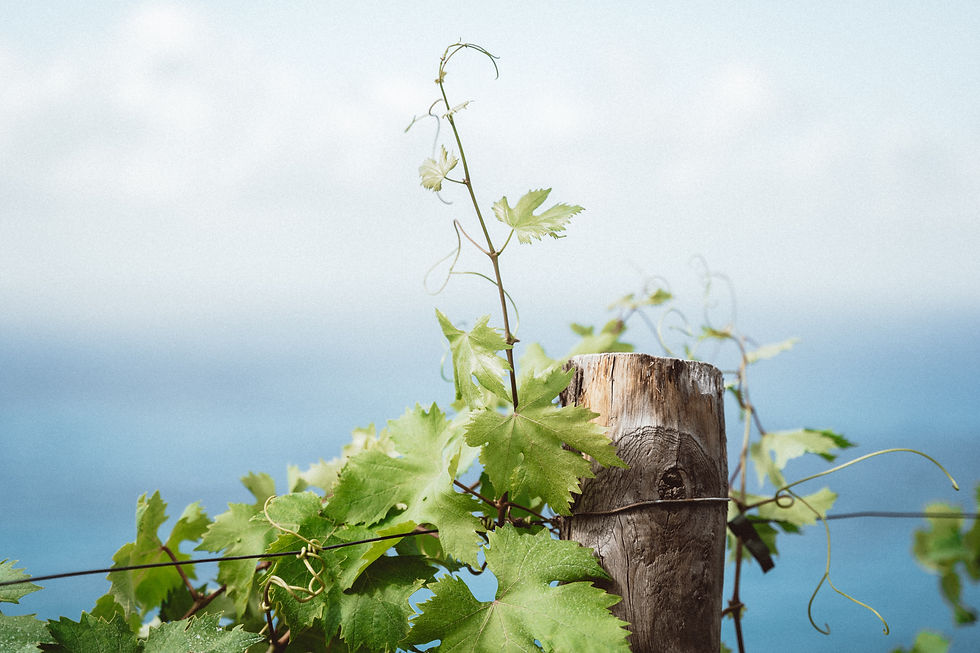An afternoon with a winemaker of Cinque Terre
- tfinerty13
- Jun 27, 2022
- 4 min read
Updated: Feb 21, 2024

Italy and wine are synonymous. Those who take that dream trip to visit the land of flavors do so knowing that each dish should always have a good glass to pair with it. In Cinque Terre, this is no different. But in the most unique photo shoot during my time in Italy, I got to go with Alessandro of Cantina Crovara up into his sections of the terraced vineyards, set against a backdrop that otherwise would only make sense in a painting.
I had already been to Cinque Terre before, but walked away with a misunderstanding that many do. I had initially thought these villages were born from the waves. Made for fishermen who cast net and line into this corner of the Mediterranean to sustain them and their families. But I was missing one of the most unique parts of these five villages - they were born from vines, not lines.
What makes the Cinque Terre so uniquely beautiful is its cliffs. These massive walls plunge straight down into the waves. Amongst those cliffs, and even sometimes upon them, sit villages. Classic Italian pastel colors stand out against the greens of the cliffs and deep blue of the Mediterranean. But a special group of people saw an opportunity where so many others saw an impossible task, how do you cultivate this land?

Where there is a will for wine, there will be a way. Men, women, and children worked for generations to turn these cliffs into terraces. Moving earth, stone, and brush day after day to fulfill a vision nobody else saw.
Today their vision remains, but as with all things, time did not pass without leaving its mark. In many of the villages there are murals and image installations to show the times gone by. Photos of families on the steep cliffs carrying the baskets of grapes back to town are good at removing any bit of “whining” that may want to arise internally after doing one of the famed hikes between the villages.
Time has moved many families of the Cinque Terre away from cultivation and towards tourism and hospitality, as it does for so many in iconic locations. But for those who remain attached to the cliff sides, a few new tools have made the job of being a winemaker a more manageable feat for those that still maintain the historic pursuit of the seaside.
My ride up to Alessandro's plot of vines that day was granted by one of these new tools. Small metal “trains” can be seen all along the cliffs now. Their tracks rising steeply along some of the most difficult areas. They are used to bring people up, and bring grapes down, while probably extending the life of everybody's knee cartilage by about 20-30 years.
We steadily rose above Manarola. Passing terrace after terrace Andrea puffed a cigarette as the cart screeched along the tracks. Stopping a few times to talk with others who still maintain their own plots of vineyard, it was evident how much the vines still connect those who look after them.
We arrived at the section and the clippers sat idle in Alessandro's pocket no longer. Now high above Manarola it was quiet. The only sound was of ocean breezes ruffling the large leaves on the vines, and the steady snipping of Alessandro removing those that had grown too large and now stole sun from the grapes.
His hands moved steadily. Eyes darting over each section of vine he made the decision to cut or not to cut quickly and without hesitation. There was an aura up in the terraces. It was serene, breezes constantly rising up the cliffs from the ocean, carrying the essential sea air to all of the grapes. The sound of rustling leaves and the clipping of pruning scissors is a soundtrack that anybody could be swept up in, especially with a backdrop like the terraces have.
I climbed a few back to get a better perspective of the work and where exactly it was being done. It was a remarkable sight, seeing Alessandro move like a typewriter down each row before stepping down and starting back in the opposite direction. Never speeding up or slowing down his steady pace was one of a person who cared not to rush and take shortcuts. Each vine would get the attention it deserved.
Alessandro now looks after sections of the terraces for some of the older families in the village. As they age and the work becomes too straining, they will ask him to help before often selling him their plot. He now has sections surrounding Manarola and dedicates himself to the work of keeping them healthy.
People like Alessandro are responsible for keeping the heartbeat of these beautiful places going. Tourism can be a blessing and a curse at times. Often slowly snuffing out the exact things that made people want to visit in the first place. But is it the efforts of the cultivators that will keep the spirit alive. The ones who wipe sweat from their brow with dirty hands as thousands of visitors grasp glasses with clean ones below.
That Italian seaside heartbeat is safe as long as people like Alessandro exist. Getting to learn from him and see the true history of what makes the wine of Cinque Terre special was one of the highlights of my entire time in Italy. And it was responsible for making already fantastic wine taste that much better.











































Comments